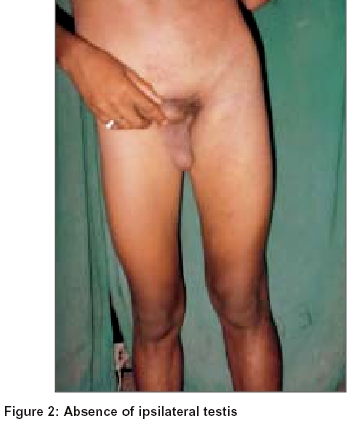Translate this page into:
Klippel � Trenaunay syndrome: Association with absence of ipsilateral testis
Correspondence Address:
C S Sirka
Department of Skin and VD, V.S.S. Medical College, Burla, Sambalpur, Orissa - 768017
India
| How to cite this article: Padhi T, Mishra S, Sirka C S. Klippel � Trenaunay syndrome: Association with absence of ipsilateral testis . Indian J Dermatol Venereol Leprol 2004;70:379-380 |
 |
 |
 |
 |
Sir,
We wish to report a case of Klippel-Trenaunay Syndrome (KTS) with absence of ipsilateral testis, a hitherto unreported association. The KTS, first described by Klippel and Trenaunay in the year 1900, classically consists of a triad of port-wine stain of limb, varicose veins and hypertrophy of soft tissues and bone of the same side. However, the current definition includes port-wine stain and increased limb size, irrespective of the presence of bony overgrowth and varicosity of veins. Though the specific genetic abnormality causing the disease has not been identified till date, a para-dominant mode of inheritance is speculated.[1] Port-wine stain or macular telangiectatic vascular nevus is the earliest, most common and characteristic clinical lesion. It usually involves the lower limb causing hypertrophy of bone and soft tissue, characterized by an increase in the length and girth.
A 16 year old male presented with multiple erythematous macules and plaques involving posterior aspect of left lower limb and left lower abdomen. The macules were present since birth and the plaques, appearing as masses of soft tissue hypertrophy, were noticed by him since last 5 years. There was a history of bleeding from the plaques with the slightest trauma. He also had scoliosis and an abnormal gait.
On examination, he was found to have lengthening of the left lower limb and varicosities of veins over the same side [Figure - 1]. The areas of soft tissue hypertrophy were nontender but there was a history of pain during walking and also profuse hemorrhage after trauma. There was no evidence of entrapment syndromes like trigger finger or carpal-tunnel syndrome. On auscultation over the affected limb, no bruit was audible. However, the left testis was found to be absent [Figure - 2]. No mass, suggestive of an undescended testis, was palpable in the lower abdomen, inguinal canal or scrotal sac. On ultrasonography of the abdomen and pelvis, no soft tissue shadow was found along the path of descent of the testis.
A plethora of associations have been reported with the KTS. They include hypertrichosis, unilateral enlargement of the tongue, trigger finger and carpal-tunnel syndrome, verrucous epidermal nevi, polydactyly and syndactyly.[2] It may also be associated with widespread venous abnormalities of the internal organs like the lungs, urinary bladder, kidney, rectum and colon.[3] Occasionally, blue naevus and macrocephaly coexist with this condition.
However, absence of the ipsilateral testicle has not been reported with this condition. Any developmental anomaly causing incomplete descent of the testis could not be confirmed because as a rule, by the age of sixteen years, such an incompletely descended testis would have been irreversibly degenerated.[4]
| 1. |
Happle R. Klippel-Trenaunay syndrome: Is it a paradominant trait? Br J Dermatol 1993;128:465-6.
[Google Scholar]
|
| 2. |
Wikler J, Starink TM. Acanthosis Nigricans like epidermal nevus and Klippel-Trenaunay syndrome. Br J Dermatol 1990;123:539.
[Google Scholar]
|
| 3. |
Hall BD. Bladder hemangioma in Klippel-Trenaunay syndrome. N Eng J Med 1971;285:1032-3.
[Google Scholar]
|
| 4. |
Russel RC, Williams NS, Bulstrode CJ, editors. Bailey and Love's Short Practice of Surgery, 23rd Ed. London: Chapman and Hall.
[Google Scholar]
|
Fulltext Views
2,073
PDF downloads
1,011





